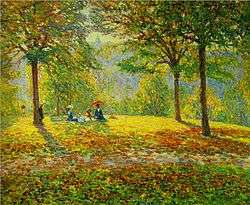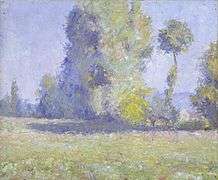Wynford Dewhurst
Wynford Dewhurst RBA (Manchester, 26 January 1864 – 9 July 1941, Burton upon Trent) was an English Impressionist painter and notable art theorist. He spent considerable time in France and his work was profoundly influenced by Claude Monet.

Biography
Wynford Dewhurst was born Thomas Edward Smith to an affluent family[1][2] in Manchester in 1864.[3] He was educated at home by a private tutor and later at Mintholme College. Although he originally trained to enter the legal profession, he showed artistic flair and decided to pursue a career as a painter after some of his drawings were published in various journals.
He gained artistic training in France at the École des Beaux-Arts, in Paris (at which time he changed his name to Wynford Dewhurst by deed poll),[4] where he was a pupil of the renowned French painter Jean-Léon Gérôme. Despite his teacher Gérome's rejection of the radical Impressionist movement in favour of a highly finished academic style (Gérome continued the development and conservation of French Neoclassicism), Dewhurst was heavily influenced by the Impressionists. It is well known that he first encountered Impressionism, to which he was instantly attracted, in the work of Emile Claus in the Maddocks Collection in Bradford. However his most important mentor would become Claude Monet.
It was Monet to whom Dewhurst dedicated his pioneering account of French Impressionism, Impressionist Painting: its genesis and development, in 1904. This was the first important study of the French painters to be published in English. As well as helping to reintroduce British artists to this style of painting, Dewhurst's book called attention to the French Impressionists' debt to the British artists John Constable and J. M. W. Turner, claiming that the Impressionists simply developed their existing painterly techniques."(By the turn of the century) British painters, if not the British public, had reconciled themselves to impressionism." [5]
According to Dewhurst, artists who, like himself, painted in an impressionist manner, were often "sneered at for imitating a foreign style",[6] and he was keen to justify their position. "French artists simply developed a style which was British in its conception",[7] he wrote, a view that was dismissed by French painters such as Pissarro, who revealed his national bias when he acknowledged Constable and Turner but identified instead French influences like Nicolas Poussin, Claude Lorrain, Jean-Baptiste-Siméon Chardin and Jean-Baptiste-Camille Corot.[8] However, Pissarro had earlier told an interviewer: "It seems to me that we are all descended from the Englishman Turner. He was the first who could make colors blaze with a natural brilliance." [9][10] The thesis that Dewhurst put forward in Impressionist Painting was controversial, for it dealt with the debated question of whether Impressionism was French or British in origin. However, it found much support in Britain: Kevin McConkey informs us that Dewhurst's theme "was taken up by others as various as Clausen, John Rothenstein and Kenneth Clark"[11][12] Nevertheless, Dewhurst's "detailed biographical notices of the most prominent artists associated with the rise of impressionism in France ... leave little to be desired from the historical point of view".[13] It is worth noting that Impressionist Painting also included an entire chapter on female artists, since "modernity is the note of Impressionism, and that movement was the very first artistic revolt in which women took part".[14] Indeed, Dewhurst thanks the celebrated female painter Mary Cassatt (who worked within the Impressionist circle) for her assistance in the preface of his book.
During his career Dewhurst became known for his paintings of the countryside around Dieppe and the Seine valley, where he painted regularly, and he confessed that it was here that his most significant artistic revelations occurred. For example, he discovered the violet light found in Monet's mid-day canvases:
I remember distinctly, during the summer of 1901, at Les Andelys-on-Seine, that upon two days and for two hours in the afternoons of those days all Nature, animate and inanimate, bore the aspect of things seen under a strong glare of violet light, exactly as though a tinted glass were suspended between the sun's rays and the earth. The effect was most curious and disturbing. Nature appears to be toneless and flat. Highlights and shadows are attenuated almost to extinction, whilst in this dull purple glare the heat became more intense than ever, possibly through lack of wind, for all was still.[15]
Throughout his life Dewhurst exhibited frequently at the Royal Society of British Artists, the New English Art Club from 1909 to 1910 and at the Royal Academy (where he also lectured on art) from 1914 to 1926. He held two one-man shows in London; the first was at the Walker Galleries in 1923, and in 1926 he held a significant exhibition of his pastels at the Fine Art Society. He also exhibited several times in Paris and Venice, in Buenos Aires in 1910, in Rome in 1911, and held a series of solo exhibitions in Germany. Examples of his work can be found in public collections: Three paintings, including Summer Mist, Valley of La Creuse (c. 1920), are in the collection of the National Museum of Wales, Cardiff. The Picnic (1908), a celebrated picture which exemplifies the influence of Monet in its use of small dabs of colour, resulting in an optical blend of hues when seen from a distance, is in the collection of Manchester City Art Gallery.
Later years
Dewhurst's mature work demonstrates a more expressive handling. This is especially evident in a series of paintings he produced in the valley of La Creuse, where the bright, almost garish palette again recalls Monet, although in some instances they achieve "an unintended Fauvist intensity."[16]
In 1995, Dewhurst was included in an important exhibition called 'Impressionism in Britain' at the Barbican Art Gallery, London, which demonstrated that the proliferation of Impressionism was not, contrary to popular belief, exclusive to France, but flourished in Britain as well where Dewhurst played an important role.
Personal life
Dewhurst had married Antonia von Bülow, of a German aristocratic family;[17] they had six children, including Royal Marine Colonel Frederick Wynford Dewhurst, who married Patricia, dau. of Sir Thomas Richard Pennefather Warren, 8th Baronet.[18][19]
Legacy
The first major retrospective of Dewhurst, Wynford Dewhurst: Manchester’s Monet, was organised by Manchester Art Gallery from 9 December 2016 to 23 April 2017.[20]
Gallery
 French Landscape, 1895
French Landscape, 1895
National Museum Cardiff Evening Shadows, 1899
Evening Shadows, 1899
Private collection Apple-Blossom time in Arc-la-Bataille
Apple-Blossom time in Arc-la-Bataille
Private collection The Blue Valley, 1908
The Blue Valley, 1908
Manchester Art Gallery
References
- https://www.theguardian.com/artanddesign/2016/dec/07/wynford-dewhurst-art-of-manchester-monet-goes-on-show
- http://www.pennilesspress.co.uk/NRB/wynford_dewhurst.htm
- "Dewhurst, Wynford". Who's Who. Vol. 59. 1907. p. 481.
- https://www.theguardian.com/artanddesign/2016/dec/07/wynford-dewhurst-art-of-manchester-monet-goes-on-show
- McConkey, Kenneth, British Impressionism (Oxford: Phaidon, 1989), p. 139.
- Wynford Dewhurst, quoted by Kenneth McConkey, British Impressionism (Oxford: Phaidon, 1989), p. 140.
- Wynford Dewhurst, Impressionist Painting: its genesis and development (London: George Newnes, 1904), pp. 4–5.
- "It is true that Turner and Constable have been useful to us, as all painters of great talent have ... But the basis of our art is evidently French". Tucker, Paul Hayes, Monet in the '90s (Yale University Press, 1989), p. 267.
- House, John, Monet: Nature into Art (Yale University Press, 1986), p. 113.
- "Pissarro objected to this preposterous claim ... This comforting theory remained vaguely absurd to the initiated of an earlier generation." McConkey, p. 140.
- Kenneth McConkey, Impressionism in Britain, exh. cat. (New Haven: Yale University Press in association with Barbican Art Gallery, 1995), p. 82.
- Support for Dewhurst's theory can be found in the publications of these writers at the following page references:
- Kenneth Clark, Landscape into Art, 1949, pp. 86–107. (Pages refer to the Pelican edition of this book, 1956).
- George Clausen, Royal Academy Lectures on Painting, 1913, p. 128.
- John Rothenstein, Nineteenth-Century Painting, 1932, p. 178.
- Also see: D. S. MacColl, Nineteenth Century Art, 1902.
- Review of Dewhurst's book 'Impressionist Painting' in The Burlington Magazine for Connoisseurs. vol. 5, no. 15, June 1904, pp. 320–321.
- Dewhurst, Impressionist Painting, p. 77.
- Wynford Dewhurst, 'What is Impressionism?' in Contemporary Review. vol. XCIX, 1911, p. 300.
- McConkey, Impressionism in Britain, p. 120.
- http://www.pennilesspress.co.uk/NRB/wynford_dewhurst.htm
- The Oldie, 1 Feb. 2017, URL= https://www.pressreader.com/uk/the-oldie/20170201/281513635873291 Date accessed= 15 Sep. 2018
- Burke's Peerage, Baronetage and Knightage, 2003, vol. 3, p. 4077
- "Wynford Dewhurst: Manchester's Monet - Manchester Art Gallery". manchesterartgallery.org. Retrieved 30 December 2016.
Writings by Dewhurst
Books
- Impressionist Painting: its genesis and development. London: George Newnes, 1904.
- Wanted: a ministry of fine arts. London: Hugh Rees Ltd, 1913. (Reprinted in The Art Chronicle.)
Articles
- 'Claude Monet, Impressionist' in The Pall Mall Magazine, June 1900.
- 'A Great French Landscapist' in The Artist, October 1900.
- 'Impressionist Painting: its genesis and development', part 1, in The Studio. vol. XXXIX, April 1903.
- 'Impressionist Painting: its genesis and development', part 2, in The Studio. vol. XXXIX, July 1903.
- 'What is Impressionism?' in The Contemporary Review. vol. XCIX, 1911.
Bibliography
- Farr, Dennis, English Art, 1870–1940. Oxford: Oxford University Press, 1978.
- Flint, Kate, Impressionists in England: the critical reception. London: Routledge, 1984.
- McConkey, Kenneth, Impressionism in Britain, exh. cat., with an essay by Anna Gruetzner Robins. New Haven: Yale University Press in association with Barbican Art Gallery, 1995.
- McConkey, Kenneth, British Impressionism. Oxford: Phaidon, 1989.
- Speiss, Dominique, Encyclopedia of Impressionists: From the Precursors to the Heirs. Helsinki: Edita, 1992.
External links
| Wikimedia Commons has media related to Wynford Dewhurst. |
| Wikiquote has quotations related to: Wynford Dewhurst |